Onkar Susladkar
ViCTr: Vital Consistency Transfer for Pathology Aware Image Synthesis
May 08, 2025Abstract:Synthesizing medical images remains challenging due to limited annotated pathological data, modality domain gaps, and the complexity of representing diffuse pathologies such as liver cirrhosis. Existing methods often struggle to maintain anatomical fidelity while accurately modeling pathological features, frequently relying on priors derived from natural images or inefficient multi-step sampling. In this work, we introduce ViCTr (Vital Consistency Transfer), a novel two-stage framework that combines a rectified flow trajectory with a Tweedie-corrected diffusion process to achieve high-fidelity, pathology-aware image synthesis. First, we pretrain ViCTr on the ATLAS-8k dataset using Elastic Weight Consolidation (EWC) to preserve critical anatomical structures. We then fine-tune the model adversarially with Low-Rank Adaptation (LoRA) modules for precise control over pathology severity. By reformulating Tweedie's formula within a linear trajectory framework, ViCTr supports one-step sampling, reducing inference from 50 steps to just 4, without sacrificing anatomical realism. We evaluate ViCTr on BTCV (CT), AMOS (MRI), and CirrMRI600+ (cirrhosis) datasets. Results demonstrate state-of-the-art performance, achieving a Medical Frechet Inception Distance (MFID) of 17.01 for cirrhosis synthesis 28% lower than existing approaches and improving nnUNet segmentation by +3.8% mDSC when used for data augmentation. Radiologist reviews indicate that ViCTr-generated liver cirrhosis MRIs are clinically indistinguishable from real scans. To our knowledge, ViCTr is the first method to provide fine-grained, pathology-aware MRI synthesis with graded severity control, closing a critical gap in AI-driven medical imaging research.
Historic Scripts to Modern Vision: A Novel Dataset and A VLM Framework for Transliteration of Modi Script to Devanagari
Mar 17, 2025Abstract:In medieval India, the Marathi language was written using the Modi script. The texts written in Modi script include extensive knowledge about medieval sciences, medicines, land records and authentic evidence about Indian history. Around 40 million documents are in poor condition and have not yet been transliterated. Furthermore, only a few experts in this domain can transliterate this script into English or Devanagari. Most of the past research predominantly focuses on individual character recognition. A system that can transliterate Modi script documents to Devanagari script is needed. We propose the MoDeTrans dataset, comprising 2,043 images of Modi script documents accompanied by their corresponding textual transliterations in Devanagari. We further introduce MoScNet (\textbf{Mo}di \textbf{Sc}ript \textbf{Net}work), a novel Vision-Language Model (VLM) framework for transliterating Modi script images into Devanagari text. MoScNet leverages Knowledge Distillation, where a student model learns from a teacher model to enhance transliteration performance. The final student model of MoScNet has better performance than the teacher model while having 163$\times$ lower parameters. Our work is the first to perform direct transliteration from the handwritten Modi script to the Devanagari script. MoScNet also shows competitive results on the optical character recognition (OCR) task.
MotionAura: Generating High-Quality and Motion Consistent Videos using Discrete Diffusion
Oct 10, 2024
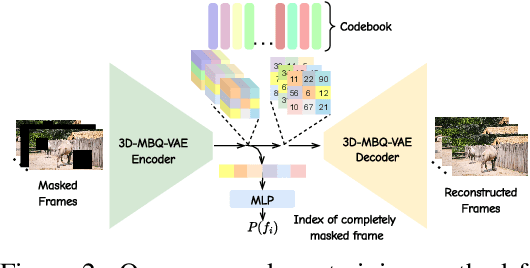
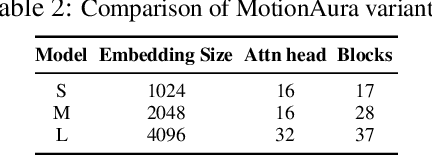

Abstract:The spatio-temporal complexity of video data presents significant challenges in tasks such as compression, generation, and inpainting. We present four key contributions to address the challenges of spatiotemporal video processing. First, we introduce the 3D Mobile Inverted Vector-Quantization Variational Autoencoder (3D-MBQ-VAE), which combines Variational Autoencoders (VAEs) with masked token modeling to enhance spatiotemporal video compression. The model achieves superior temporal consistency and state-of-the-art (SOTA) reconstruction quality by employing a novel training strategy with full frame masking. Second, we present MotionAura, a text-to-video generation framework that utilizes vector-quantized diffusion models to discretize the latent space and capture complex motion dynamics, producing temporally coherent videos aligned with text prompts. Third, we propose a spectral transformer-based denoising network that processes video data in the frequency domain using the Fourier Transform. This method effectively captures global context and long-range dependencies for high-quality video generation and denoising. Lastly, we introduce a downstream task of Sketch Guided Video Inpainting. This task leverages Low-Rank Adaptation (LoRA) for parameter-efficient fine-tuning. Our models achieve SOTA performance on a range of benchmarks. Our work offers robust frameworks for spatiotemporal modeling and user-driven video content manipulation. We will release the code, datasets, and models in open-source.
Towards Synergistic Deep Learning Models for Volumetric Cirrhotic Liver Segmentation in MRIs
Aug 08, 2024



Abstract:Liver cirrhosis, a leading cause of global mortality, requires precise segmentation of ROIs for effective disease monitoring and treatment planning. Existing segmentation models often fail to capture complex feature interactions and generalize across diverse datasets. To address these limitations, we propose a novel synergistic theory that leverages complementary latent spaces for enhanced feature interaction modeling. Our proposed architecture, nnSynergyNet3D integrates continuous and discrete latent spaces for 3D volumes and features auto-configured training. This approach captures both fine-grained and coarse features, enabling effective modeling of intricate feature interactions. We empirically validated nnSynergyNet3D on a private dataset of 628 high-resolution T1 abdominal MRI scans from 339 patients. Our model outperformed the baseline nnUNet3D by approximately 2%. Additionally, zero-shot testing on healthy liver CT scans from the public LiTS dataset demonstrated superior cross-modal generalization capabilities. These results highlight the potential of synergistic latent space models to improve segmentation accuracy and robustness, thereby enhancing clinical workflows by ensuring consistency across CT and MRI modalities.
D2Styler: Advancing Arbitrary Style Transfer with Discrete Diffusion Methods
Aug 07, 2024Abstract:In image processing, one of the most challenging tasks is to render an image's semantic meaning using a variety of artistic approaches. Existing techniques for arbitrary style transfer (AST) frequently experience mode-collapse, over-stylization, or under-stylization due to a disparity between the style and content images. We propose a novel framework called D$^2$Styler (Discrete Diffusion Styler) that leverages the discrete representational capability of VQ-GANs and the advantages of discrete diffusion, including stable training and avoidance of mode collapse. Our method uses Adaptive Instance Normalization (AdaIN) features as a context guide for the reverse diffusion process. This makes it easy to move features from the style image to the content image without bias. The proposed method substantially enhances the visual quality of style-transferred images, allowing the combination of content and style in a visually appealing manner. We take style images from the WikiArt dataset and content images from the COCO dataset. Experimental results demonstrate that D$^2$Styler produces high-quality style-transferred images and outperforms twelve existing methods on nearly all the metrics. The qualitative results and ablation studies provide further insights into the efficacy of our technique. The code is available at https://github.com/Onkarsus13/D2Styler.
Large-Scale Multi-Center CT and MRI Segmentation of Pancreas with Deep Learning
May 20, 2024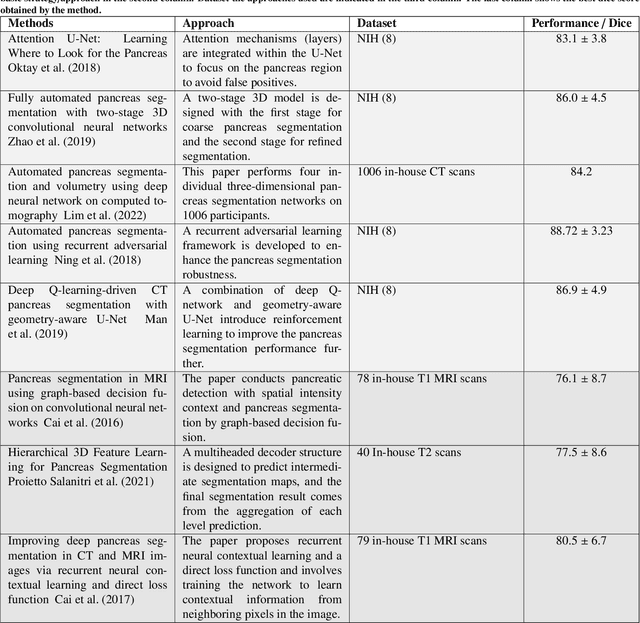
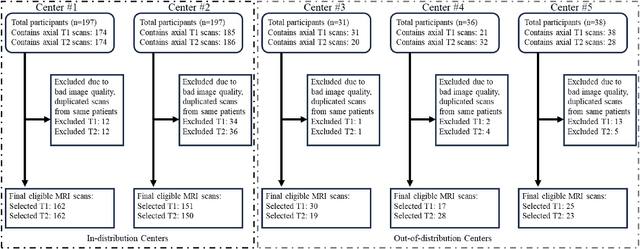
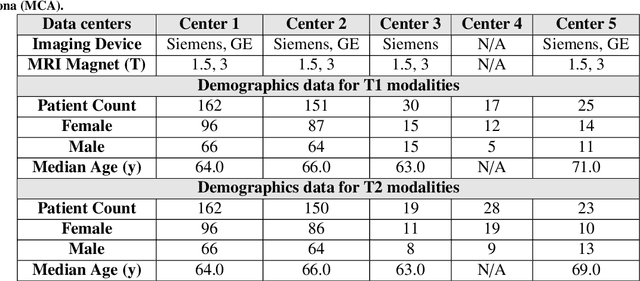
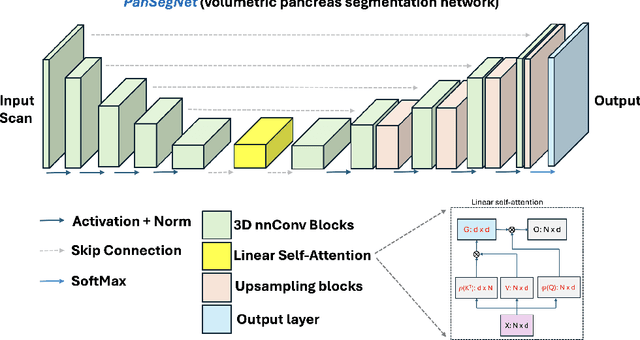
Abstract:Automated volumetric segmentation of the pancreas on cross-sectional imaging is needed for diagnosis and follow-up of pancreatic diseases. While CT-based pancreatic segmentation is more established, MRI-based segmentation methods are understudied, largely due to a lack of publicly available datasets, benchmarking research efforts, and domain-specific deep learning methods. In this retrospective study, we collected a large dataset (767 scans from 499 participants) of T1-weighted (T1W) and T2-weighted (T2W) abdominal MRI series from five centers between March 2004 and November 2022. We also collected CT scans of 1,350 patients from publicly available sources for benchmarking purposes. We developed a new pancreas segmentation method, called PanSegNet, combining the strengths of nnUNet and a Transformer network with a new linear attention module enabling volumetric computation. We tested PanSegNet's accuracy in cross-modality (a total of 2,117 scans) and cross-center settings with Dice and Hausdorff distance (HD95) evaluation metrics. We used Cohen's kappa statistics for intra and inter-rater agreement evaluation and paired t-tests for volume and Dice comparisons, respectively. For segmentation accuracy, we achieved Dice coefficients of 88.3% (std: 7.2%, at case level) with CT, 85.0% (std: 7.9%) with T1W MRI, and 86.3% (std: 6.4%) with T2W MRI. There was a high correlation for pancreas volume prediction with R^2 of 0.91, 0.84, and 0.85 for CT, T1W, and T2W, respectively. We found moderate inter-observer (0.624 and 0.638 for T1W and T2W MRI, respectively) and high intra-observer agreement scores. All MRI data is made available at https://osf.io/kysnj/. Our source code is available at https://github.com/NUBagciLab/PaNSegNet.
Towards Scene-Text to Scene-Text Translation
Aug 06, 2023Abstract:In this work, we study the task of ``visually" translating scene text from a source language (e.g., English) to a target language (e.g., Chinese). Visual translation involves not just the recognition and translation of scene text but also the generation of the translated image that preserves visual features of the text, such as font, size, and background. There are several challenges associated with this task, such as interpolating font to unseen characters and preserving text size and the background. To address these, we introduce VTNet, a novel conditional diffusion-based method. To train the VTNet, we create a synthetic cross-lingual dataset of 600K samples of scene text images in six popular languages, including English, Hindi, Tamil, Chinese, Bengali, and German. We evaluate the performance of VTnet through extensive experiments and comparisons to related methods. Our model also surpasses the previous state-of-the-art results on the conventional scene-text editing benchmarks. Further, we present rigorous qualitative studies to understand the strengths and shortcomings of our model. Results show that our approach generalizes well to unseen words and fonts. We firmly believe our work can benefit real-world applications, such as text translation using a phone camera and translating educational materials. Code and data will be made publicly available.
MOVESe: MOVablE and Moving LiDAR Scene Segmentation with Improved Navigation in Seg-label free settings
Jun 26, 2023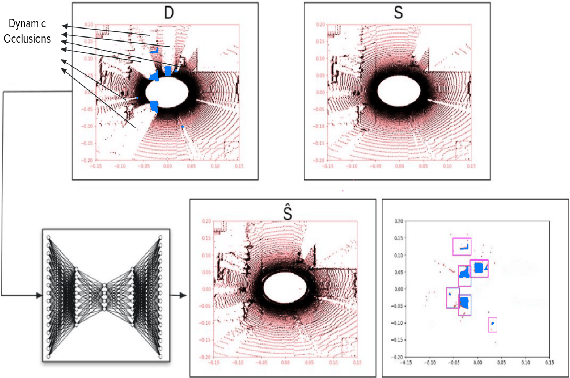

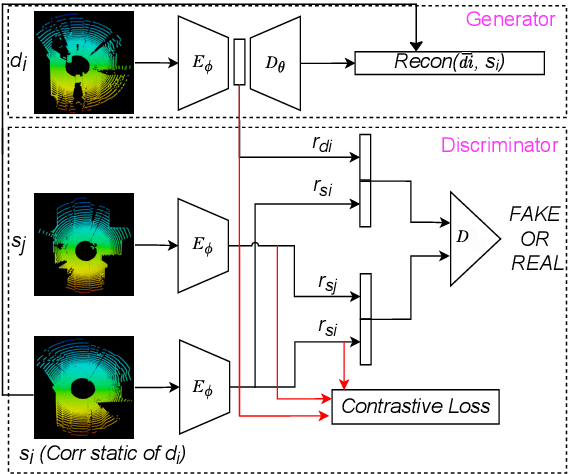

Abstract:Accurate detection of movable and moving objects in LiDAR is of vital importance for navigation. Most existing works focus on extracting and removing moving objects during navigation. Movable objects like pedestrians, parked vehicles, etc. although static may move in the future. This leads to erroneous navigation and accidents. In such cases, it becomes necessary to detect potentially movable objects. To this end, we present a learning-based approach that segments movable and moving objects by generating static parts of scenes that are otherwise occluded. Our model performs superior to existing baselines on static LiDAR reconstructions using 3 datasets including a challenging sparse industrial dataset. We achieve this without the assistance of any segmentation labels because such labels might not always be available for less popular yet important settings like industrial environments. The non-movable static parts of the scene generated by our model are of vital importance for downstream navigation for SLAM. The movable objects detected by our model can be fed to a downstream 3D detector for aiding navigation. Though we do not use segmentation, we evaluate our method against navigation baselines that use it to remove dynamic objects for SLAM. Through extensive experiments on several datasets, we showcase that our model surpasses these baselines on navigation.
TPFNet: A Novel Text In-painting Transformer for Text Removal
Oct 27, 2022


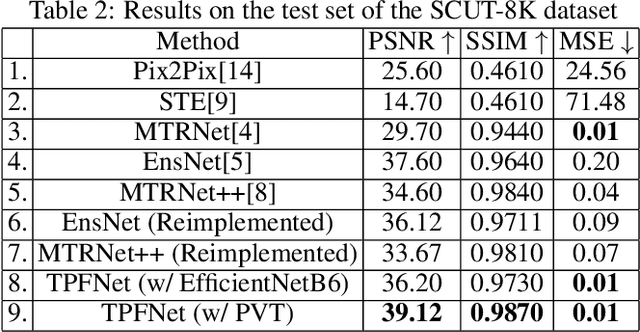
Abstract:Text erasure from an image is helpful for various tasks such as image editing and privacy preservation. In this paper, we present TPFNet, a novel one-stage (end-toend) network for text removal from images. Our network has two parts: feature synthesis and image generation. Since noise can be more effectively removed from low-resolution images, part 1 operates on low-resolution images. The output of part 1 is a low-resolution text-free image. Part 2 uses the features learned in part 1 to predict a high-resolution text-free image. In part 1, we use "pyramidal vision transformer" (PVT) as the encoder. Further, we use a novel multi-headed decoder that generates a high-pass filtered image and a segmentation map, in addition to a text-free image. The segmentation branch helps locate the text precisely, and the high-pass branch helps in learning the image structure. To precisely locate the text, TPFNet employs an adversarial loss that is conditional on the segmentation map rather than the input image. On Oxford, SCUT, and SCUT-EnsText datasets, our network outperforms recently proposed networks on nearly all the metrics. For example, on SCUT-EnsText dataset, TPFNet has a PSNR (higher is better) of 39.0 and text-detection precision (lower is better) of 21.1, compared to the best previous technique, which has a PSNR of 32.3 and precision of 53.2. The source code can be obtained from https://github.com/CandleLabAI/TPFNet
ACLNet: An Attention and Clustering-based Cloud Segmentation Network
Jul 13, 2022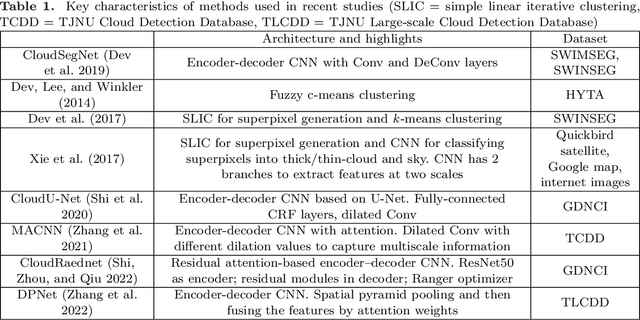
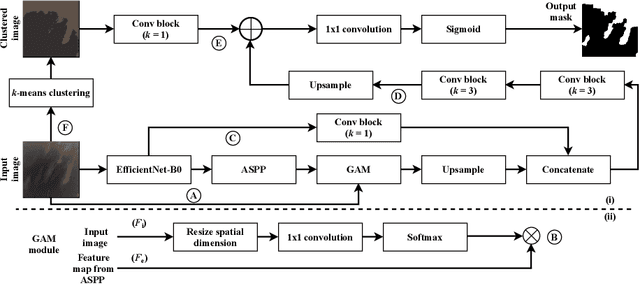
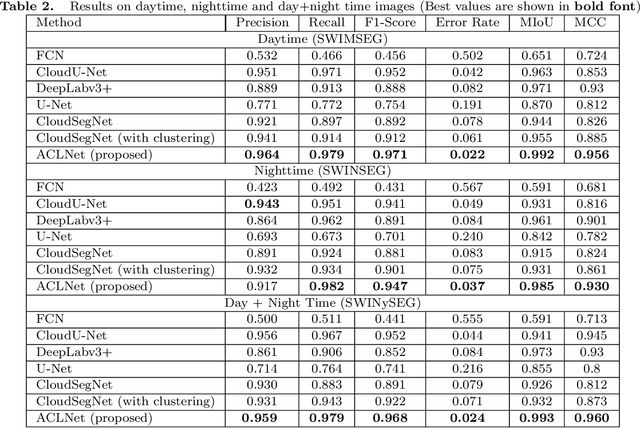
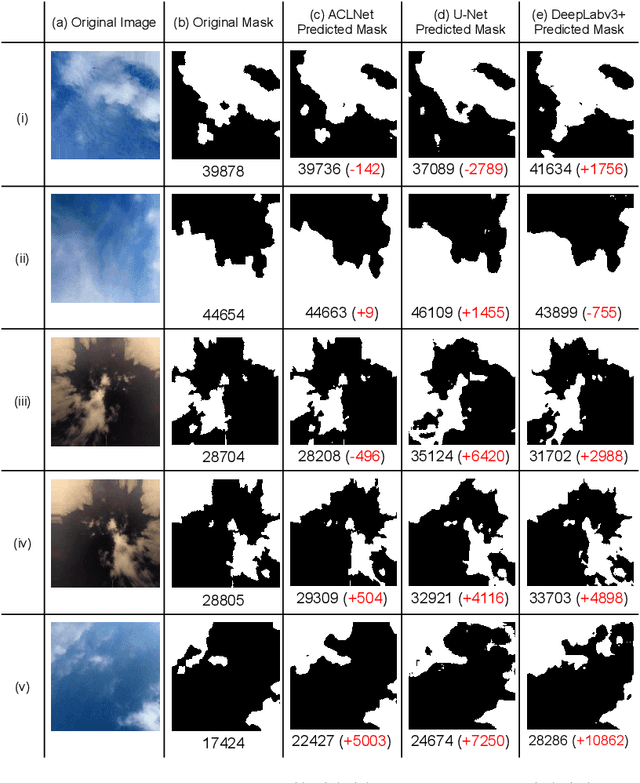
Abstract:We propose a novel deep learning model named ACLNet, for cloud segmentation from ground images. ACLNet uses both deep neural network and machine learning (ML) algorithm to extract complementary features. Specifically, it uses EfficientNet-B0 as the backbone, "`a trous spatial pyramid pooling" (ASPP) to learn at multiple receptive fields, and "global attention module" (GAM) to extract finegrained details from the image. ACLNet also uses k-means clustering to extract cloud boundaries more precisely. ACLNet is effective for both daytime and nighttime images. It provides lower error rate, higher recall and higher F1-score than state-of-art cloud segmentation models. The source-code of ACLNet is available here: https://github.com/ckmvigil/ACLNet.
* 11 pages, 3 figures, 5 tables, Published in remote sensing letters
 Add to Chrome
Add to Chrome Add to Firefox
Add to Firefox Add to Edge
Add to Edge